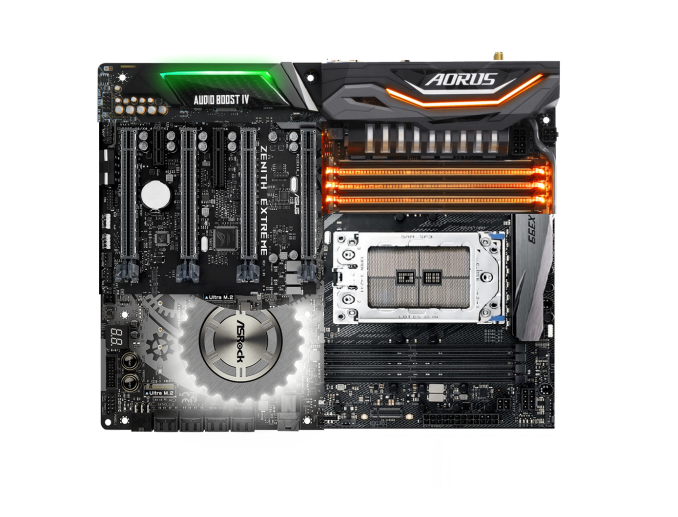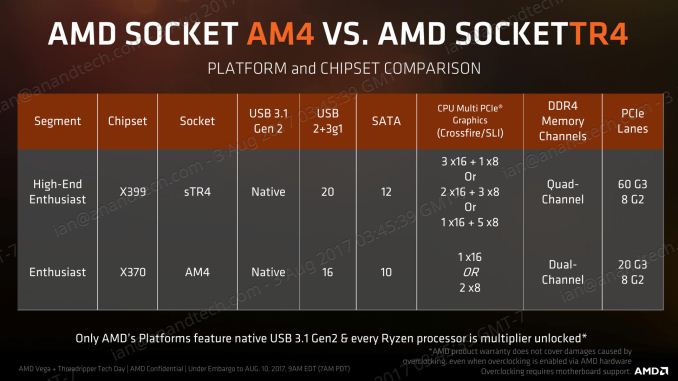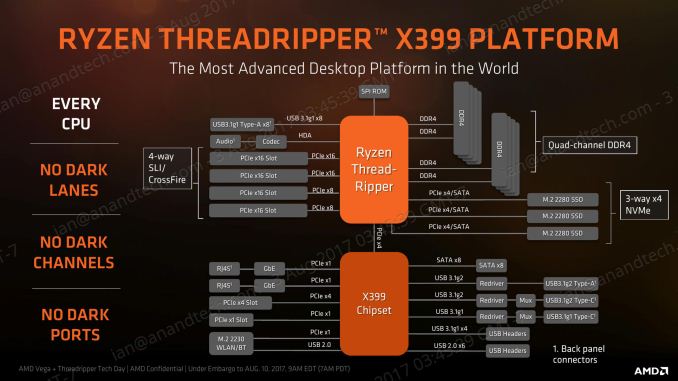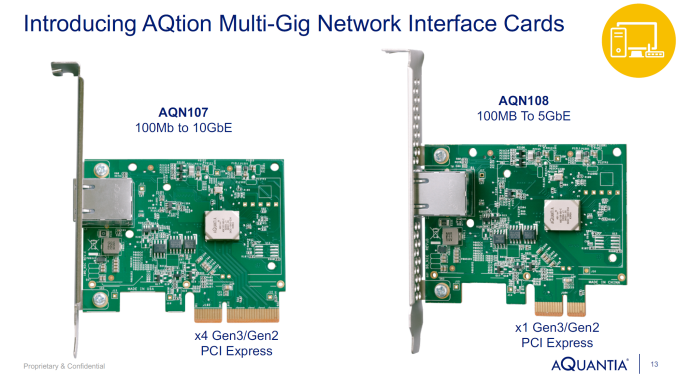An AMD Threadripper X399 Motherboard Overview: A Quick Look at Seven Products
by Ian Cutress & Joe Shields on September 15, 2017 9:00 AM EST
With the release of AMD’s Threadripper CPUs into the HEDT market, board partners have released new motherboards based on the X399 chipset. Consumers are going to see quad channel memory, native 4-Way SLI and Crossfire capabilities, more full-speed M.2 slots, added 10G network ports, and more on the new platform. We're taking a quick look at each of the motherboards that the vendors are promoting in the market, as well as a few upcoming teasers.
Related Reading
- The AMD Ryzen Threadripper 1950X and 1920X Review: CPUs on Steroids
- AMD Threadripper Unboxing
- AMD Threadripper 1920X and 1950X CPU Details: 12/16 Cores, 4 GHz Turbo, $799 and $999
- AMD CPU Updates: 16 Core Threadripper w/64 PCIe Lanes This Summer, Epyc Launching June 20th
AMD Ryzen Threadripper Needs a Mother(board)
A big takeaway from our AMD Ryzen Threadripper 1950X and 1950X review is the increase in CPU connected PCIe 3.0 lanes. A full 60 lanes are available to the PCIe slots and M.2 drives, while 4 lanes head off to the chipset where it's muxed for USB, SATA, low-level I/O, and other features. The increase in CPU PCIe lanes is set up to allow for a lot more flexibility connecting devices using PCIe bandwidth.
The four major players, ASRock, ASUS, GIGABYTE, and MSI, have launched X399 motherboards for Threadripper. These boards equip the massive 4094-pin socket with eight DIMM slots to cover the four memory channels and then differentiate themselves in PCIe configuration, IO, styling and software support.
Unlike Ryzen, the base processor is not a true SoC as the term has evolved over the years. In order to get the compliment of SATA and USB ports, each Threadripper CPU needs to be paired with an X399 chipset. So aside from the CPU PCIe lanes, the 'new' X399 chipset also gets some IO to play with:
Unlike mainstream platforms that have several chipsets to choose from that vary in capability and cost, the AMD high-end platform only has a single chipset, similar to Intel's X299. As we've learned over the last few months, some elements of the motherboard base cost, such as the socket, can cost a pretty penny to the board manufacturers, which in turn will be forwarded on to the user. These motherboards appear to start somewhere around $249-$299, with the top board so far set at $549. Guess which one AMD sent us for our CPU review.
The Underlying Block Diagram
When PCIe is the game, it becomes time to play with controllers and ports to see what fits. It all starts with the underlying diagram for Threadripper and X399:
AMD's marketing on the left is set out to explain that each product in the Threadripper and X399 line will be 'fully enabled' - none of the chips will be limited in PCIe lane counts or DRAM for the sake of segmentation. AMD is happy at this point to keep segmentation limited to cores, frequency, and L3 cache.
The diagram shows the two hubs for everything to connect to: the CPU and the chipset. The CPU has 60 PCIe lanes, provided in 3 or 4 PCIe root complexes at x16 each (the diagram above suggests x16/x8/x16/x8). These will often go towards the main PCIe slots to support add-in cards like GPUs, or they could be partitioned off for RAID controllers or fast ethernet if required. In total, AMD has stated that the platform can support six GPUs maximum. The CPU also supports eight USB 3.1 (5 Gbps) Type-A ports, quad channel DDR4, and support for up to three PCIe 3.0 x4 storage drives for 3-way NVMe.
Threadripper CPUs reserve four PCIe lanes for the chipset, which similar to Intel acts like a PCIe switch for more IO - although AMD only offers a few lanes here compared to Intel's 24 PCIe 3.0 x4 lanes.
From the chipset there are eight PCIe lanes, which AMD here has suggested reserving two for gigabit Ethernet, four for a PCIe x4 slot, one for a PCIe x1 slot, and one for a WiFi module. Alongside the PCIe lanes are eight SATA ports, six USB 2.0 ports, four USB 3.1 (5 Gbps) Type-A ports, one USB 3.1 (5 Gbps) Type-C port and two USB 3.1 (10 Gbps) ports with appropriate redrivers. In a change to what we normally see on Intel motherboards, AMD lists SPI and Audio features as coming from the CPU rather than the chipset.
AMD Suggests Variants
As part of the launch, AMD is wanting to promote the different ways in which an X399 motherboard could be arranged depending on the workload requirements.
| X399 Potential Configurations | |||
| Use | PCIe Lanes | Total | |
| Content Creator | 2 x Pro GPUs 2 x M.2 Cache Drives 10G Ethernet 1 x U.2 Storage 1 x M.2 OS/Apps 6 x SATA Local Backup |
x16/x16 from CPU x4 + x4 from CPU x4 from CPU x4 from CPU x4 from CPU From Chipset |
52 Lanes |
| Extreme PC | 2 x Gaming GPUs 1 x HDMI Capture Card 2 x M.2 for Games/Stream 10G Ethernet 1 x M.2 OS/Apps 6 x SATA Local Backup |
x16/x16 from CPU x8 from CPU x4 + x4 from CPU x4 from CPU x4 from CPU From Chipset |
56 Lanes |
| Streamer | 1 x Gaming GPU 1 x HDMI Capture Card 2 x M.2 Stream/Transcode 10G Ethernet 1 x U.2 Storage 1 x M.2 OS/Apps 6 x SATA Local Backup |
x16 from CPU x4 from CPU x4 + x4 from CPU x4 from CPU x4 from CPU x4 from CPU From Chipset |
40 Lanes |
| Render Farm | 4 x Vega FE Pro GPUs 2 x M.2 Cache Drives 1 x M.2 OS/Apps 6 x SATA Local Backup |
x16/x8/x8/x8 x4 + x4 from CPU x4 from CPU From Chipset |
52 Lanes |
Each of these potential configurations would run into several thousand dollars a piece for a full build - the M.2 drives were suggested at 512GB minimum, with the SATA drives in RAID configurations as well. AMD is making no joke; they want to be the premium platform.
New Controllers for X399
With each of these motherboard overviews, we like to cover a few of the newer controllers to hit the market that motherboard manufacturers might take advantage of. Given the recent X299 launch on the Intel side, not much has changed since. The big parts to enter the consumer space are Aquantia's multi-gigabit ethernet controllers.
Aquantia launched two ethernet controllers: the AQC107 which supports 100MB, 1G, 2.5G, 5G and 10G, and the AQC108 which supports 100MB, 1G, 2.5G and 5G, all through standard RJ45 connectors. Motherboard manufacturers can use these controllers directly on the boards, or bundle them in add-in cards like the AQN107 and AQN108 above. We've seen cards from ASUS and GIGABYTE already hit the market based on these controllers, while ASRock and MSI prefer to integrate them direct.
The second controller worth mentioning is the updated ASMedia ASM3142 controller, providing USB 3.1 Gen 2 (10 Gbps) functionality to motherboards that need more USB 3.1g2. Originally we saw the ASM1142 single lane controller, while the ASM2142 integrated a dual lane design such that all the ports had peak bandwidth when multiple ports are in use. ASM3142 is a low powered version of the ASM2142, but still supporting all the ports at peak bandwidth.
Third is the updated Realtek ALC1150 audio codec, known as the ALC1220. The ALC1220 improves peak SNR while adding new functionality. ASUS run a customized version known as the ALC1220A, which removes some of the excess function for a stripped down version unique to them but configured in a partnership with Realtek.
The Motherboards
The seven motherboards we have to discuss are:
- The ASRock X399 Taichi
- The ASRock X399 Professional Gaming
- The ASUS X399 ROG Zenith Extreme
- The ASUS Prime X399-A
- The ASUS Strix X399-E Gaming
- The GIGABYTE X399-Gaming 7
- The MSI X399 Gaming Pro Carbon
- The MSI X399 SLI Plus
Added on 9/19: The GIGABYTE X399 Designare EX
Added on 10/10: The MSI X399 SLI Plus




















99 Comments
View All Comments
vgray35@hotmail.com - Saturday, September 16, 2017 - link
A few % better - you are looking at it wrong. Platinum PSU units with peak 94% efficiency means 6% heat dissipated. Now at 99% efficiency that is 1% dissipated as heat. That means a 5/6th reduction in heat or 83% less heat which is not just a few percent better. Further the new topology yields a >70% cost reduction which is also not insignificant. Gas turbines are also too noisy by the way, which is the main reason these are not considered (expensive when they go wrong too), and thus not a good comparison versus improvements being discussed here. Are you saying the linked article on PWM-resonance and resonance scaling topology is not worthwhile, or the problems with Buck converter inductors is not a severely limited and highly noisy power solution? Perhaps Power Electronics engineering is not your field of interest at all!Manch - Monday, September 18, 2017 - link
ICE is not 60% less efficient than a gas turbine. A gas turbine doesn't scale downward well. One of similar power would actually less efficient as an equivalent rated ICE. Gas turbines are impractical for vehicles.One benefit of a turbine would be no tailgating. The intake would suck in and crap out small critters all over your windshield.
vgray35@hotmail.com - Friday, September 15, 2017 - link
Yes I appreciate that - we draw power (Watts) at the rate of Joules of energy per second, Notice I said "we draw power", but that is also directly reflected proportionally as current in Amps (or a rate of Coulombs per sec), There was not a direct inference that power is measured in Amps, but only (a) "We are drawing a measure of power", and (b) this is approaching proportionally a resultant 150A. Yes I probably could have said better, but in wise did I say power is measured in AMPS.vgray35@hotmail.com - Friday, September 15, 2017 - link
I do not believe a defacto motto of the industry is "we are wasting 5% in heat, so let us not bother with wasting only 1%). Clearly you did not read the link to the Power Electronics article (I surmise), as then you would have realized the solution offers a huge reduction in cost as well as heat. The cost factor is something everybody is interesting in, even the industry at large, in my humble opinion.ddriver - Friday, September 15, 2017 - link
Huge? Like what? 6-7% better? Maybe 8-9%?What I meant is the solution you linked to is like 99% efficient, a good buck converter is what? Like 90-92%?
That's nowhere near the difference between an internal combustion engine and a gas turbine, the latter being more than twice more efficient. And still no adoption, even thou the solution is not really all that complex, and decades old. They still only use gas turbines in the most demanding applications, which is pretty much the same as with the converters from that article, which that dude developed for NASA's most demanding applications. I am pretty sure computers in NASA run on buck converters too, and they will use his designs only for the stuff they launch into space.
You probably don't realize how immense of an impact it would have if all cars on the planet become more than twice as efficient, burning more than twice as little fuel, outputting less than half the harmful emissions, traveling twice as far on a single fill. It would completely dwarf the benefits of boosting computer power converters from 90 to 99% :)
I am not saying it is not cool, I am just saying there have been a lot more beneficial a lot more high priority solutions that haven't been adopted yet for a lot longer, so you should not be surprised that the entire industry hasn't switched to a new power converter design overnight. They will do as they will always do, they will milk the cow until it dies, and then make it into jerky, and only then will then go for the new and better thing.
vgray35@hotmail.com - Saturday, September 16, 2017 - link
As noted earlier, 92% which is 8% heat versus 99% which is 1% heat means a 7/8th reduction in heat or 87% reduction. Thinking this is only a 7% improvement differential is incorrect - it is in this example an 87% improvement. That is not small potatoes. When this is coupled with a corresponding large cost reduction, then it becomes apparent the chip manufacturers would rather make more money using the older technology. Maybe the PSU engineers are just plain lazy or are not following the advances in their field as they are snowed under with work.Let's keep the discussion focused on power supplies.vgray35@hotmail.com - Saturday, September 16, 2017 - link
The 600W @ 12V fed to the motherboard with ~8% losses is ~50W heat in the VRMs (driving 180W CPU, 320W GPU, leaving 100W for other parts), The ATX power supply is 90% efficient or less with 60W heat also in the same case. The GPU power supply also is another 25W waste power supply heat, for a total of 135W of waste heat (as opposed to the useful heat generated within the various components themselves, which is heat generated from useful work being done). It is tough to manage this 660W in the case, but over 135W of it (>21% low ball estimate) is waste heat from just power supplies alone (ATX PSU, VRMs, GPU supply), of which over 80% or 110W could be eliminated by abandoning the Buck converter topology. This of course is a simplistic view, as there are other components too that are ignored here, for brevity's sake. I suspect >25% of heat comes from power supplies alone which can be dramatically curtailed. It's a 3 ringed circus: ATX PSU steals 10% for itself, motherboard steals another 8% for itself and GPU steals a further 8% for itself. We have no control over the power drawn from the mega chips themselves, but we do have control over the power supplies that drive them, and manufacturers could be doing a lot better here. And this is by no means a monster power hungry system with only one high-end graphics card. A >85% reduction in power supply waste heat can be realized if the Buck converter is abandoned, and that applies to resonant LLC power supplies also. The motherboard manufacturers and ATX PSU manufacturers need to take this aspect much more seriously.http://www.powerelectronics.com/power-management/s...
AMD's Thread Ripper X399 and Intel's X299 platforms should have been their first attempt at abandoning the Buck, half-bridge, and resonant LLC topologies. They failed us in that regard. We need this fiasco to come to an end by using hybrid PWM-resonant switching and resonance scaling, which eliminates the ferrite cored inductors altogether, and replaces them with just copper traces on the PCB. This is not rocket science.
Oxford Guy - Saturday, September 16, 2017 - link
Motherboard makers seem pretty much incompetent. They can't even be bothered to issue BIOS updates to fix serious bugs.ddriver - Sunday, September 17, 2017 - link
Yeah, but then again, an overclocked TR is like 200W, even an entry level car is like 200 KILOWATTS. So percentages are not really that much indicative.The facts remain. A TR mobo with a better power regulator circuit will save like 10 watts of power, a car with a gas turbine engine will save like 100 KW of power.
That's 10 000 times larger saving measured on absolute scales. What's more important in your opinion? Saving a watt, or saving 10 000 watts? Naturally, I'd rather have both. The goal here is to illustrate how low of a priority it is to improve mobo power delivery compared to some other, longer standing improvement opportunities that have been ignored.
Icehawk - Sunday, September 17, 2017 - link
They tried turbine cars, they are terrible due to the way they deliver power. Several successful drag cars have used them as in that application the power delivery works well. Same reason we aren't going to be driving rocket cars.